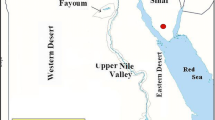Abstract
Variants of gynes and workers occur in a substantial number of ant species; however, dacetine ergatoid gynes have been recorded just once in the literature thus far. In the present paper, we provide abridged descriptions of five ergatoid female reproductives in five species of Neotropical dacetines belonging to two genera: Acanthognathus brevicornis Smith, Acanthognathus ocellatus Mayr, Acanthognathus rudis Brown & Kempf, Strumigenys cosmostela Kempf, and Strumigenys hindenburgi Forel. We also compare the ergatoids with conspecific gynes and workers.






Similar content being viewed by others
References
Bolton B (2000) The ant tribe Dacetini. Mem Am Entomol Inst 65:1–1028
Bolton B (2003) Synopsis and classification of Formicidae. Mem Am Entomol 71:1–370
Brown WL (1961) The neotropical species of the ant genus Strumigenys Fr. Smith: miscellaneous concluding studies. Psyche 68:58–69
Brown WL, Kempf WW (1960) A world revision of the ant tribe Basicerotini. Stud Entomol 3:161–250
Brown WL, Kempf WW (1969) A revision of the neotropical dacetine ant genus Acanthognathus (Hymenoptera: Formicidae). Psyche 76:87–109
De Andrade ML, Baroni Urbani C (1999) Diversity and adaptation in the ant genus Cephalotes, past and present. Stutt Beitr Natkd B 271:1–889
Diniz JLM (1998) Biology of Blepharidatta ants, the sister group of the Attini: a possible origin of fungus-ant symbiosis. Naturwissenschaften 85:270–274
Forel A (1915) Formicides d’Afrique et d’Amérique nouveaux ou peu connus. IIe partie. Bull Soc Vaud Sci Nat 50:335–364
Heinze J (1998) Intercastes, intermorphs, and ergatoid queens: who is who in ant reproduction? Insectes Soc 45:113–124
Kempf WW (1975) Report on Neotropical Dacetine ant studies (Hymenoptera: Formicidae). Rev Bras Biol 34:411–424
Mann WM (1916) The Stanford expedition to Brazil, 1911, John C. Branner, Director. The ants of Brazil. Bull Mus Comp Zool 60:399–490
Mayr G (1887) Südamerikanische Formiciden. Verh geol Reichsanst 37:511–632
Michener CD (1974) The social behavior of the bees. Harvard University Press, Cambridge
Molet M, Fisher BL, Ito F, Peeters C (2009) Shift from independent to dependent colony foundation and evolution of ‘multi‐purpose’ ergatoid queens in Mystrium ants (subfamily Amblyoponinae). Biol J Linn Soc 98(1):198–207
Molet M, Wheeler DE, Peeters C (2012) Evolution of novel mosaic castes in ants: modularity, phenotypic plasticity, and colonial buffering. Amer Nat 180(3):328–341
Peeters C (2012) Convergent evolution of wingless reproductive across all subfamilies of ants, and sporadic loss of winged queens. Myrmecol News 16:75–91
R Development Core Team (2008) R: a language and environment for statistical computing. R Foundation for Statistical Computing, Vienna, Austria. (http://www.R-project.org)
Silva RR, Brandão CRF (2010) Morphological patterns and community organization in leaf-litter ant assemblages. Ecol Monographs 80(1):107–124
Smith MR (1944) A key to the genus Acanthognathus Mayr, with the description of a new species (Hymenoptera: Formicidae). Proc Entomol Soc Wash 46:150–152
Wheeler WM (1908) The polymorphism of ants. Ann Entomol Soc Am 1:39–69
Wheeler DE (1986) Developmental and physiological determinants of caste in social Hymenoptera: evolutionary implications. Amer Nat 128:13–34
Wilson EO (1971) The insect societies. Belknap press of Harvard university press. Mass, Cambridge
Acknowledgments
We would like to thank the collectors of the specimens here described and to Rogério R. Silva, Tiago Carrijo, and Rodolfo Probst for assistance with the formulation of the R scripts, especially regarding graphical parameters. Fernando Augusto Schmidt cordially loaned us an ergatoid of Strumigenys cosmostela, which was deposited in the Formicidae collection of the Universidade Federal de Viçosa. Also, three anonymous reviewers contributed with valuable comments and suggestions. We acknowledge the support by the Coordenação de Aperfeiçoamento de Pessoal de Nível Superior in the form of a grant to TSR Silva (CAPES) and support by Conselho Nacional de Desenvolvimento Científico e Tecnológico (CNPq) and Fundação de Amparo à Pesquisa do Estado de São Paulo (FAPESP) to CRF Brandão.
Author information
Authors and Affiliations
Corresponding author
Additional information
Edited by Takumasa Kondo – CORPOICA
Rights and permissions
About this article
Cite this article
Silva, T.S.R., Brandão, C.R.F. Further Ergatoid Gyne Records in the Ant Tribe Dacetini (Formicidae: Myrmicinae). Neotrop Entomol 43, 161–171 (2014). https://doi.org/10.1007/s13744-013-0192-7
Received:
Accepted:
Published:
Issue Date:
DOI: https://doi.org/10.1007/s13744-013-0192-7




